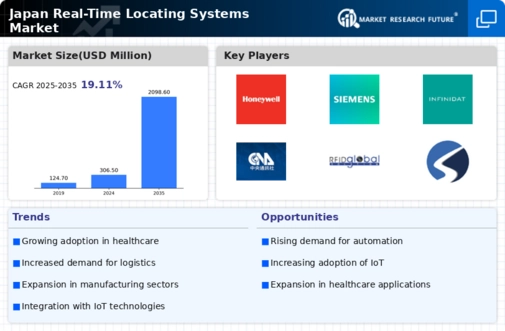Increased Focus on Safety and Security
The real time-locating-systems market in Japan is significantly influenced by the heightened emphasis on safety and security across various sectors. Organizations are increasingly implementing these systems to monitor personnel and assets, ensuring compliance with safety regulations. For instance, in industries such as construction and manufacturing, real time-locating-systems help track worker locations, thereby enhancing safety protocols. The market is projected to witness a growth rate of around 12% as companies prioritize the protection of their workforce and assets. This focus on safety not only mitigates risks but also fosters a culture of accountability, further driving the adoption of real time-locating-systems.
Integration with Smart City Initiatives
The real time-locating-systems market in Japan is increasingly intertwined with the country's smart city initiatives. As urban areas evolve, there is a growing need for efficient management of resources and services. Real time-locating-systems contribute to this by enabling better traffic management, public safety, and resource allocation. The Japanese government has been actively promoting smart city projects, which are expected to drive the adoption of real time-locating-systems in urban environments. This integration not only enhances the quality of life for residents but also presents lucrative opportunities for businesses operating in the market. The anticipated growth in smart city investments is likely to further propel the demand for real time-locating-systems.
Growing Demand for Asset Tracking Solutions
The real time-locating-systems market in Japan experiences a notable surge in demand for asset tracking solutions across various sectors. Industries such as manufacturing, logistics, and retail are increasingly adopting these systems to enhance operational efficiency and reduce losses. According to recent data, the asset tracking segment is projected to grow at a CAGR of approximately 15% over the next five years. This growth is driven by the need for real-time visibility of assets, which helps organizations optimize inventory management and streamline supply chain processes. As companies seek to improve their competitive edge, the integration of real time-locating-systems into their operations becomes essential, thereby propelling the market forward.
Rising Demand for Smart Logistics Solutions
The real time-locating-systems market in Japan is experiencing a significant boost due to the rising demand for smart logistics solutions. As e-commerce continues to flourish, companies are seeking innovative ways to enhance their logistics operations. Real time-locating-systems provide critical insights into shipment tracking, inventory management, and delivery optimization. Recent statistics indicate that the logistics sector is expected to grow by approximately 10% annually, with real time-locating-systems playing a crucial role in this transformation. By leveraging these systems, businesses can improve customer satisfaction through timely deliveries and efficient supply chain management, thereby reinforcing the market's growth trajectory.
Advancements in Technology and Infrastructure
Technological advancements play a pivotal role in shaping the real time-locating-systems market in Japan. The proliferation of high-precision positioning technologies, such as Ultra-Wideband (UWB) and Bluetooth Low Energy (BLE), enhances the accuracy and reliability of locating systems. Furthermore, the Japanese government has been investing in infrastructure development, including the expansion of 5G networks, which facilitates seamless connectivity for real time-locating-systems. This infrastructure improvement is expected to boost market growth, as it allows for faster data transmission and improved system performance. As a result, businesses are more inclined to adopt these advanced solutions, leading to a more robust market landscape.





















Leave a Comment